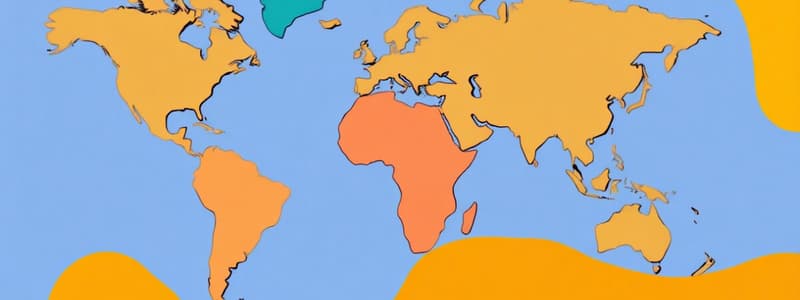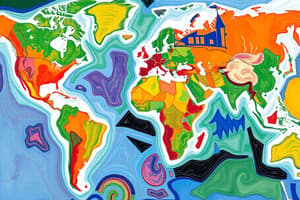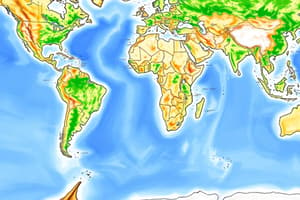Podcast
Questions and Answers
What does Physical Geography focus on?
What does Physical Geography focus on?
- The economic activities of human societies
- The Earth's natural processes and features (correct)
- Cultural practices of different regions
- The political structures of countries
Which of the following is NOT a sub-branch of Human Geography?
Which of the following is NOT a sub-branch of Human Geography?
- Urban Geography
- Population Geography
- Climatology (correct)
- Economic Geography
What is the primary purpose of Geographic Information Systems (GIS)?
What is the primary purpose of Geographic Information Systems (GIS)?
- To forecast weather conditions
- To create artful representations of maps
- To analyze and visualize geographic data (correct)
- To gather firsthand information through observation
Which concept refers to an area with shared characteristics?
Which concept refers to an area with shared characteristics?
What does the term 'spatial analysis' refer to in geography?
What does the term 'spatial analysis' refer to in geography?
Which of the following best describes 'sustainability'?
Which of the following best describes 'sustainability'?
Which technique involves using technology to gather information from a distance?
Which technique involves using technology to gather information from a distance?
What is the main focus of Human-Environment interactions in geography?
What is the main focus of Human-Environment interactions in geography?
Flashcards
What is Geography?
What is Geography?
The study of the Earth's surface, including its physical features, human populations, and the interactions between them.
Physical Geography
Physical Geography
Examines the Earth's natural processes and features, such as climate, landforms, water bodies, and ecosystems.
Human Geography
Human Geography
Explores the spatial patterns and relationships of human activities and societies.
Spatial Analysis
Spatial Analysis
Signup and view all the flashcards
Place
Place
Signup and view all the flashcards
Region
Region
Signup and view all the flashcards
Cartography
Cartography
Signup and view all the flashcards
Remote Sensing
Remote Sensing
Signup and view all the flashcards
Study Notes
Introduction to Geography
- Geography is the study of the Earth's surface, including its physical features, human populations, and the interactions between them.
- It encompasses a wide range of topics, from the distribution of natural resources to the development of urban areas.
- Geographic inquiry involves observing, describing, explaining, and predicting spatial patterns and processes.
- Geographical techniques, like mapping, remote sensing, and GIS analysis, are crucial for understanding spatial relationships.
Branches of Geography
- Physical Geography: Examines the Earth's natural processes and features, such as climate, landforms, water bodies, and ecosystems.
- Sub-branches include: geomorphology (landforms), hydrology (water), climatology (climate), biogeography (distribution of life).
- Human Geography: Explores the spatial patterns and relationships of human activities and societies.
- Sub-branches include: population geography, economic geography, urban geography, political geography.
Key Concepts in Geography
- Spatial analysis: Examining the arrangement and distribution of phenomena across space.
- Place: A specific location with unique characteristics.
- Region: An area with shared characteristics, like climate or culture.
- Scale: The level of detail examined, from local to global.
- Interaction/Interdependence: How different parts of the Earth are connected and influence each other.
- Location: Absolute (latitude/longitude) or relative (in reference to other places).
- Movement: How people, goods, and ideas travel and relocate.
Geographic Techniques
- Cartography: The science of mapmaking, using different map projections.
- Remote sensing: Using technology like satellites and aircraft to gather information from a distance.
- Geographic Information Systems (GIS): Using computer systems to analyze and visualize geographic data.
- Fieldwork: Gathering firsthand information through observation.
- Qualitative methods: Using data for descriptions and interpretations.
- Quantitative methods: Using data and observations to test statistical relationships.
Human-Environment Interactions
- How human activities impact the environment (e.g., pollution, deforestation).
- How environmental factors influence human societies (e.g., climate change, natural disasters).
- Sustainability: Finding ways to meet present needs without compromising future generations.
- Environmental issues: Including global climate change, loss of biodiversity, and pollution.
Importance of Geography
- Understanding global issues: Helping to address problems like resource scarcity, conflict, climate change.
- Enhancing decision-making: Providing geographic insights for planning and policy-making.
- Promoting better understanding of different cultures and lifestyles through spatial analysis.
- Enhancing environmental awareness: Helping societies understand and mitigate their impact on the environment and promote sustainable practices.
Studying That Suits You
Use AI to generate personalized quizzes and flashcards to suit your learning preferences.




